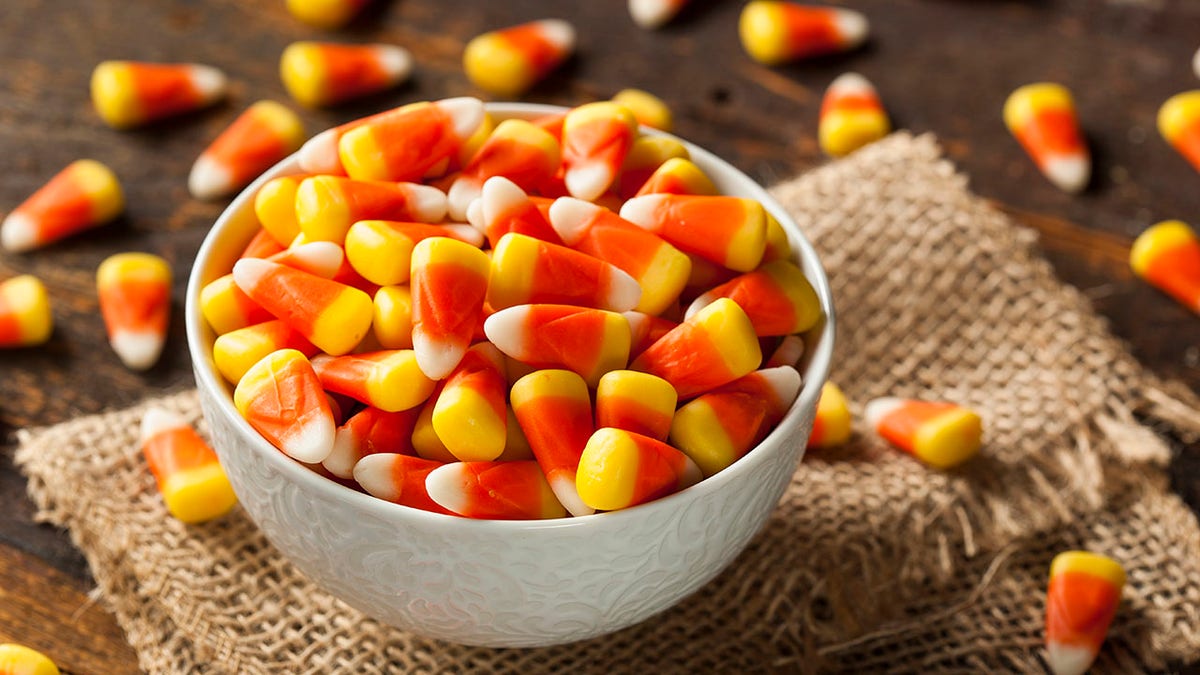Kyle Richards on making 'Halloween' movies
Kyle Richards discussed making "Halloween" as a child versus the sequels as an adult, and what it means to her to have such a dedicated fandom supporting her.
With Halloween coming up very quickly, American households are about to get a deluge of candy — whether they are giving it out or taking it in.
Want to help moderate that sugar intake among your kids while making it educational and eye-opening for them at the same time?
Try out this (tax) plan to pace the candy consumption in your home — while also teaching your kids about taxes and how America runs. (Since when has that subject ever been so sweet — or tart! — as the case may be?)
HALLOWEEN BY THE NUMBERS: FUN FACTS ABOUT THE SPOOKY DAY
Here's how to do it.
First, ask your kids to put their candy in a big pile and count it
As they do this, encourage them to gaze upon the treasure trove of yumminess they collected.
Let them get excited about their stash.

Happy Halloween day with ghost candies, pumpkin bowl, Jack O lantern and decorations. (iStock)
Then, ask them to count how many pieces they have.
See what number they come up with before you turn to your next request.
Now, ask your kids to imagine their Halloween candy is like money
As you ask them to imagine this, tell them that you — as the parent — are going to be like our government.
"What’s government?" they’ll ask.
Remind them that Mom and Dad work hard in their jobs to earn money that helps pay for your house, food, clothes, cars and toys.
After reminding them that Mom and Dad work hard in their jobs to earn money that helps pay for your house, food, clothes, cars and toys, explain that our government requires people who earn money to pay taxes to allow for the many things the public — our family, neighbors, and people all across our country — enjoys.
PUMPKIN SPICE (AND EVERYTHING NICE): CONSUMERS LOVE IT BECAUSE THERE'S BRAIN SCIENCE BEHIND IT
Those taxes go to pay for a lot: roads and bridges, parks, military, schools, Grandma and Grandpa’s health care costs, jails, the needs of people who do not have jobs and more.
Next, decide on your kid's tax bracket
Depending on your preference, you can either use real figures based on your family’s federal tax rate (you can reference easily available federal income tax information).

Watch the learning that occurs when you take away the percentage of your kids' candy that corresponds to your family’s tax bracket! (iStock)
Or — you can use any simple taxing percentage (e.g. 10%, 25%) for this introductory exercise.
Then, help your young ones do the ‘math’
Take away the percentage of their candy that corresponds to your family’s tax bracket.
Tell your kids, as part of this educational exercise, "Now this candy belongs to me. I provide the home you live in, the clothes you wear and the food you eat."
EATING PUMPKIN MAY HELP YOU LOOK YOUNGER AND LOSE WEIGHT, EXPERTS SAY
Watch their mouths gape open as their pile of goodies dwindles!
You can explain to your kids, basically, that the more money you make, the more you will pay in taxes.
Be clear to your kids that while votes for our lawmakers — (kid translation: the line leaders who decide the rules we have to follow) — have influence over how much we pay the government in taxes. As citizens, we must pay our assigned amount based on those rates that are decided by our elected officials.
If we don't, we are breaking the law. Those consequences can range from having to pay even more money to being sent to prison (reassure them that neither of those things will actually happen to them!).
Continue with your ‘candy as money’ explanation
You can explain to your kids, basically, that the more money you make, the more you will pay in taxes.
So even if you work harder to earn more money — even if you work harder to collect more candy — you will still need to pay more money (more candy).

Parents can explain to their kids, as part of this Halloween-season learning experience, that for every three pieces of candy they choose to give to someone else, you will give them one piece of candy back. (iStock)
At the same time, if you make less money — or collect fewer pieces of candy — you will not be required to pay as much in taxes.
Also make note that in addition to having to pay taxes, we choose to give to charities — like your church, temple, food pantry or other civic organization.
HALLOWEEN COSTUMES 2022: 11 IDEAS FOR KIDS
Doing this lets us choose how we want our money to help others, and it also can lessen the taxes we owe to the government, though not completely.
Use the pieces of candy as models
To model this latter concept, explain to the kids that for every three pieces of candy they choose to give to someone else, you will give them one piece of candy back.
Discuss the specific nonprofit organizations your family chooses to support and why.

If you've followed along so far with this Halloween lesson plan for your kids — now they might be ready for the state tax explanation. (iStock)
Ask your kids to think about how much they would want to give to support their favorite charities (perhaps ask them this question before and after paying their candy tax to see how generosity can fluctuate!).
If you want to take a step further into teaching federalism to your children — (kid translation: Washington, D.C., doesn't get to make all the decisions, since power is divided between Washington, D.C., and each of America’s 50 states) — then it’s time for state income tax!
Now, let's talk about state taxes!
Explain that the previous exercise was all about the U.S. government, the one that serves all the states.
Now they will need to pay even more money — pay more candy — to the state government.
For this engaging exercise, have the kids decide in which state they will "live."
You’ll need to take away more candy from your Californian and New Yorker — but your little Floridian won’t need to pay one Snickers more.
Say one chooses to live in California (where the top income tax rate was 12.3% in 2019), another in New York (8.82% in 2019) and still another in Florida (0% since 1924).
You’ll need to take away more candy from your Californian and New Yorker — but your little Floridian won’t need to pay one Snickers more.

Your kids might need to add "tax rate" to their list of reasons for wanting to move to Florida like many other Americans in recent years! (iStock)
Your kids might add "tax rate" to their list of reasons for wanting to move to Florida like many other Americans in recent years! (Alaska, New Hampshire, South Dakota, Tennessee, Texas, Washington and Wyoming are the other states with no income tax.)
From there, depending on the age of your child, you could get into local taxes — you’ll know best how to gauge their ability to consume the realities of adult life
Here's where they discover the truth
Right around this time period, your kids might discover the truth that Ann Landers, the famous advice columnist, did and shared with others: "A person doesn’t know how much he has to be thankful for until he has to pay taxes on it."
You might ask them, "If your candy taxes were money, how would you hope your government leaders would spend it?"
So, ask your kids a few questions relating to how they feel about paying taxes.
You might ask them, for example, "If your candy taxes were money, how would you hope your government leaders would spend it?"
Or how about these questions: "How would you hope our leaders would spend the money on roads, so we can drive our cars safely? On parks and playgrounds so we can meet and play with other members of our community? On schools so we can learn?"

Ask your young trick-or-treaters a few questions about how they feel about paying taxes (or giving up candy). (iStock)
OR: "On homeless shelters so we can help people who are unable to help themselves? On the military and its heroes, so we can support them in keeping us safe?"
Finally, surprise the kids with this turn of events
As a final idea to close out this civic-minded pretend play — on Halloween, who knew? — return your kids' taxed candy back to them!
HISTORY OF HALLOWEEN: THE ORIGINS OF THE HOLIDAY
As relief washes over the faces of your sweet candy monsters, you can explain that, fortunately, Mom and Dad are not the government.
Instead, it is your joyful and personal responsibility to care for them, protect them and delight them.

Enjoy chatting with your kids about their thoughts on those questions as you share a bag of M&Ms with them! (iStock)
It is also your job to teach them how the world works — and to help them think about how it can work better.
For example, how does this exercise make them think differently about the relationships between money, work and government?
FOLLOW US ON FACEBOOK FOR MORE LIFESTYLE NEWS
Does it make them think taxes should be higher (to pay for some really important stuff) — or lower (so people can earn their keep and decide how to spend it)?
For whom should it be higher or lower? And why?
CLICK HERE TO GET THE FOX NEWS APP
Enjoy chatting with your kids about their thoughts on those questions as you share a bag of M&Ms.
And remember: It’s not a tax when you freely share your bounty!





















